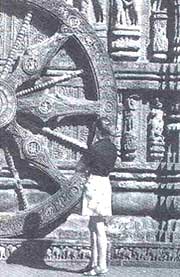Preserving a crumbling fragment of history
 HISTORIANS, archaeologists and art-lovers all over the country are eagerly awaiting the day when the Archaeological Survey Of India (ASI) and the Orissa state works department take up renovation of the inside of the Sun Temple at Konark.
HISTORIANS, archaeologists and art-lovers all over the country are eagerly awaiting the day when the Archaeological Survey Of India (ASI) and the Orissa state works department take up renovation of the inside of the Sun Temple at Konark.
It will be a historic moment as the renovation will mean reopening of the mukhsala (the main porch of the temple), which has been closed to visitors since 1903 when it was filled with dry masonry and sand to prevent its walls and roof from collapsing.
Extensive damage
The urgent need for restoration of the interior of the 39 metre high porch was realised in 1991, when archaeological experts and engineers noticed that years of water leakage and high relative humidity had caused extensive damage to the garbha griha (sanctum sanctorum) of an older temple, the Jagannath temple in Puri. The sight "terrified" the experts, says ASI superintending archaeologist G C Chauley, prompting them to consider restoration and conservation measures for the Sun Temple, too, before it met a similar fate.
The state government recently submitted to the Centre a report on the proposed conservation measures -- estimated to cost Rs 7 crore -- for the Sun Temple. A P Gupta of the Indian Institute of Technology in Kharagpur, head of the expert committee for the Puri temple, is guiding conservation measures for the Sun Temple as well, while two reputed firms from Calcutta who undertook grouting -- filling gaps with thin, fluid mortar -- in the Puri temple, have also been involved.
The grouting and pinning technologies used in the Puri temple can be applied in the Sun Temple, too, both the monuments having been built with the same type of stone. Polymer modified cement (PMC) and epoxy resin have been used in the Jagannath Temple for grouting and pinning of the corbels (projections sticking out of a wall to support a weight). PMC is both stronger and better at preventing water penetration than other materials.
So far, conservation work on the Sun Temple has been limited to structural renovation and chemical preservation of its exteriors. After the wornout and missing stones are replaced with new stones, the exposed surfaces are treated with mild chemicals, usually a mixture of dilute ammonia. A special detergent called Teepol is then used to remove moss and lichen from the stone surface. Then the surface is treated with paper pulp so that all soluble salts can be extracted. The cleaned surface is then treated with a fungicide such as zinc silico fluoride to check any new vegetational growth and a preservative such as polymethyl methacrylate to slow down the processes of salination and withering.
Earlier efforts
Efforts to repair and preserve the more than 750-year-old temple were begun in 1793 by the king of Khurda, Divya Simha Dev, but he was arrested by the British before he could restore the sculptures.
In the 1940s, extensive casuarina plantations were grown around the temple to check the impact of sand grains blown by the wind. Measures undertaken by ASI include clearing of sand and debris, rectification of wrong slopes, replacement of rusted clamps and damaged or missing stones, installation of a proper drainage system, chemical treatment of stones and gravity grouting of open joints.
The efforts at preserving the Sun Temple are still far from complete, but as superintending archaeological chemist A S Maiti puts it, the temple provides archaeologists "such a challenging task that it will force them to keep at it".
